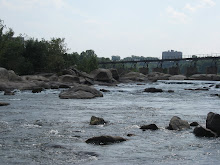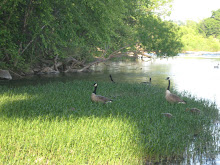Jack Gartside, a well known fly tier residing in Boston, states that fly tying is an activity in which your fingers and eyes take your imagination on an angling voyage when life prevents you from physically doing so (please forgive my paraphrasing). As you sift through mounds of feathers, furs and synthetics your mind immediately transforms these materials into an object- an object which may just be the ticket to a dream. As a new fly tyer it has become clear that there are five basic components (note I did not state guidelines or rules) to dwell on when fly tying.
(1) Pattern
Pattern as a heading is a bit a vague, but rightfully so due to the numerous manifestations of sensory input that fish associate with forage. Scientifically, this is know as the search image-patterns of sensory input which animals translate into a feeding opportunity. In tying terms, pattern refers to the type of critter you are trying to imitate-crustaceans like crayfish, bait fish, macroinvertabrates (i.e. aquatic insects), terrestrials etc. These headings can be decomposed even further. For instance, are you imitating the larval, nymph or adult stage of aquatic insects? Are you going to tie terrestrial insects or mammals including grass hoppers, cicadas and small rodents respectfully? The final pattern category may be the ugly Betty-those flies that simply catch the fish's attention through being big, colorful and narly (a circus peanut comes to mind).
(2) Material Properties
This is often a frustrating one for tyers as we face endless options of tying materials available for purchase. This is apparent after your first trip to a fly shop, whether you visit one down the road or via cyber space. The type of material you tie with may be straight forward if you are using recipes of well known flies; however, creative tyers take note of a material's action and properties. Consider the following:
a. Does the material pulsate and flow in a fleshy manner, or is it stiff and rigid (think of the action rabbit and marabou relative to that of EP fibers used for many bait fish patterns)? This will greatly influence the fly's profile.
b. Is the material hydrophobic, that is, does it repel water or absorb it like a sponge? This property will greatly impact the sink rate of a fly.
c. Related to item 'b', how buoyant is the material? In addition to the degree of hydrophobicity, a a materials density can affect its buoyancy.
d. How well does the material push or move water? The lateral line on a fish enables it to detect pressure due to displaced water, so patterns that incorporate materials that push water as they are stripped are often good attracting patterns. The wool head on some articulated streams accomplishes this.
e. How well does the material reflect light?
(3) Color and Size
Many anglers who match the hatch can often be caught debating whether it is more important to match the color or size of particulate insects; this also undoubtedly applies to matching the prevalent bait fish species, so even the Striper folks are guilty! Two parameters dictate the color and size of a fly: (1) the forage being imitated and (2) current conditions. The extent to which fish are keying on particular prey items can influence how closely the color and size must be matched. Light availability is the main ingredient impacting how well fish see particular colors, and light availability is a function of depth, cloud cover, time of day and the water's silt and sediment load. When tying streamers I have found that chartreuse, purple, olive and white are suitable for most situations.
(4) Castability
This item became ever so clear the first time I tried to cast a a 5 inch bunny leech with a 5wt rod using a small tippet...anyone who has ever sailed a fly through the air as their tippet snaps understands this. Consider how heavy (wet weight) and bulky (this impacts air resistance) the fly is, and how well your particular set up will handle this mass.
(5) There are no rules!
You can tie with any material, of any color, in any combination to your heart's content. Many tyers get caught up, and often limited, when they think there are strict guidelines and only a certain way to craft a particular fly. Going back to my opening statement, allow your imagination to wander...strive to build a pattern that you can call your own. Granted, the staples (e.g. Clousers, deceivers, Elk Hair Caddis) have their places and have proven their abilities like a seasoned veteran athlete. But, I am willing to bet that your rookies can out compete these guys if you give them the time and effort they deserve!
September 21, 2008
September 17, 2008
Fish Pics - Spring and Summer 2008
Ahhhh....It felt like early fall!




Beautiful rays of sun, a nice gentle breeze and temperatures in the mid 70s-absolutely perfect conditions for creek stomping. The snooze button (damn that thing!) got the best of me; as a matter of face, it delayed my day by five hours. I was out of bed at 10am rather than 5am like I had planned for. Ah well, the river was still where I left it last time-like a good friend! Today's efforts yielded a 11icnh large mouth taken on a little sparkie (my version of an electric deceiver) and a descent size small mouth, which opted for a marabou streamer I tie (pictured above, both the articulated and non-articulated versions). The large mouth held it ground for a good while and felt very strong, unlike the more agile small mouths which like to run, jump and splash.
My new tying materials arrived early last week, so I have been on a week-long tying binge ever since. Today I had the opportunity to take these flies for a swim, and they preformed well other than the holographic eyes with "water proof" adhesive-note the quotation marks. Looks like I am going to have to get used to using Zap-a-Gap and having my fingers stuck together from now on.
The small mouth were very curious today as they would chase down and engage in a staring competition with all of my flies. The fish would either swim along side my flies admiring my tying abilities (apprently, lack there of), or immediately strike it. I am still having issues with hook sets, so next time out I will be trying flies with stinger hooks on them; this should indicate whether short strikes or my line control is the issue. Fish were found in the same usually haunts: slow placid runs approximately 2-3ft deep below a major rapid, current seams and around boulders. The small mouth were most active between 11 and 2pm when it was sunny and calm. A breeze picked up and clouds moved during the latter afternoon hours, but fish were still around and playful.
I am slowly learning that how one approaches a piece of water often dictates whether or not fish are interested in your offerings. Specifically, I had much succuss by walking out and around a run or pool in the down stream direction, and then reapproaching the pool from downstream. It is helpful to walk behind boulders, bushes and vegetation in order to position yourself; I theorize such structures dampen your vibration and hide you while absorbing your shadow. If the water is not super clear and fish are bold, use the same technique but move upstream instead of downstream in order to fish a more tradition swing. In fact, an area adjacent to river access is holding many fish which will only hit a fly if I circle downstream 25 yards or so behind bridge supports and on the backside of islands. Unproductice approaches include walking the bank and waiting till fish until you are immediately adjacent to fishy waters hovering above. I also believe you are better off fishing closer to the water's surface rather than perched high above it (i.e. maintain a low profile unless you have grey blue feathers, sharp beak and a 4ft wing span). Also, try casting back away from the water's edge if possible even if your visibility of the pool is skewed.
Subscribe to:
Comments (Atom)























